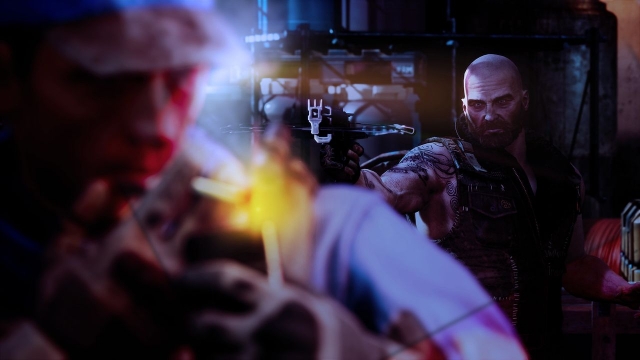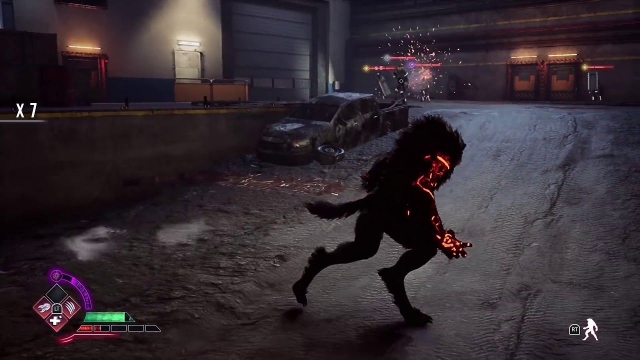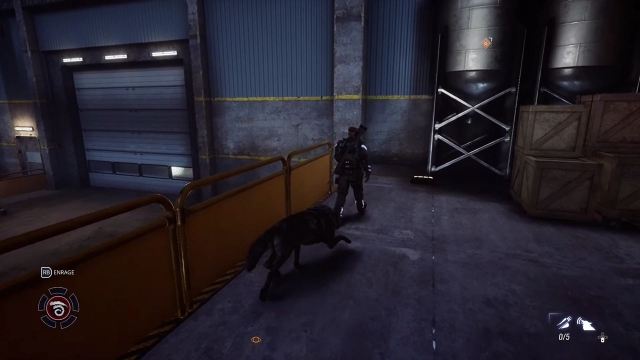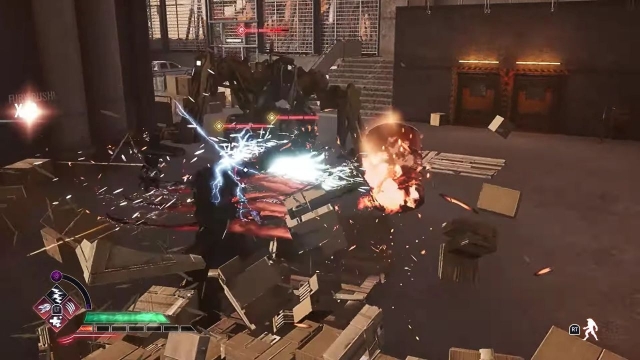Werewolf: The Apocalypse – Earthblood
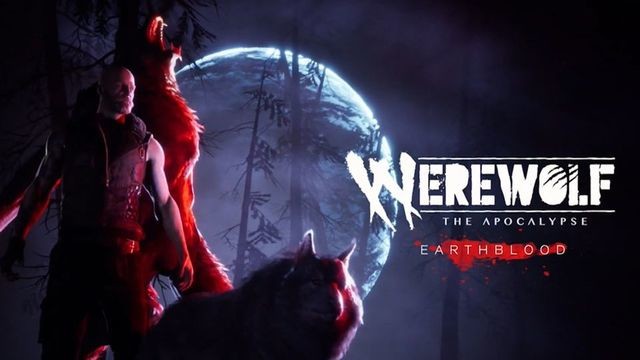
The term “Eurojank” is often used somewhat fondly in the gaming community. It migrated over from the world of board games, to describe a certain feel that you sometimes get when playing mid- to low-budget European projects.
In general, a “Eurojanky” game is packed fat with ideas, but doesn’t quite have the level of polish or commitment that was required to carry them to their natural conclusion. That doesn’t necessarily make them bad; they’re just odd in a way that’s often indefinable.
Werewolf: The Apocalypse – Earthblood is Eurojank incarnate.
When you play it, you can see what its designers were doing, and there are some genuinely good ideas here, but it’s still decidedly raw in the middle. At its best, Earthblood feels like a recently-unearthed B-list PS2 game from around 2004; at its worst, it’s like somebody tried to make Mass Effect 2 with a tenth of the necessary budget.
Earthblood is the product of Cyanide, the French studio that made 2018’s too-faithful-by-half Call of Cthulhu. Both games make some odd choices; both games feature a level of faithfulness to their source material that’s so thorough that it might actually be damaging to the final product.
It’s a strange experience, overall, particularly because I have no idea how accessible Earthblood is. I played a lot of the Werewolf tabletop game in college, so I’m conversant with most of the lore. If I wasn’t, I’m not sure I’d have any idea what’s happening here.
With a lot of fiction that involves an elaborately detailed setting like this one, full of secret societies, new vocabulary, and what amounts to its own subculture, the traditional setup is to make the viewpoint character as new to it all as the player/reader is. For example, in Vampire: The Masquerade – Bloodlines, you’ve been a Kindred for about ten minutes at the start of the game, so both you and your character get to learn about the world of vampires and your powers at the same time.
Earthblood doesn’t make things that easy. You’re shoved right into the deep end from the jump, playing as Cahal, a middle-aged, experienced werewolf who’s been around for a long time, and who’s surrounded by other werewolves and their allies who know the score as well as he does. A newcomer to the lore, then, is mostly left twisting in the wind as the game drops a whole tabletop rulebook’s worth of terminology on you.
Werewolf is set in the same universe as Vampire, the World of Darkness, a modern-day urban fantasy where monsters are real and operate just under the surface of society. In Werewolf’s case, you play as the Garou, a race of rage-fueled shapeshifters who regard themselves as the Earth’s immune system.
The Garou’s primary enemy is the Wyrm, an ancient spirit that went crazy millennia ago. Originally, it was meant as a force of positive destruction, which would clear away the old so new things could grow in its place, but now it’s entirely corruptive. The Garou have been fighting it for all of their recorded history, but they’re losing badly, both due to the Wyrm’s power and their own tendency to make the worst decisions possible at any given time.
Cahal’s pack of Garou in particular has targeted Endron, an oil company that’s an arm of the Pentex corporation, which in turn is a tool of the Wyrm. Pentex’s various subsidiaries all operate as wastefully as possible, dragging society down with them and further polluting the environment around them, and Endron is among the worst. (It’s actually kind of cool when you look around Endron’s various offices, as they’re full of shout-outs to other Pentex subsidaries, some of which are incredibly obscure to anyone who hasn’t read one particular sourcebook from maybe 1999.)
Unfortunately, Cahal’s next mission goes badly. His wife dies–the fact that Earthblood starts off with the main character’s wife getting “fridged” is another thing that makes it feel like it’s about 17 years old–and while mad with grief, Cahal accidentally kills another Garou. He decides to exile himself from his home in Washington state, leaving his daughter with his brother-in-law.
Five years later, Cahal discovers his old home’s in trouble, and returns to defend it just in time to keep it from burning down entirely. He ends up as one of the last Garou standing, as his old packmates and their new allies make a last all-or-nothing strike against Endron.
Practically, Earthblood is a fusion of two different sorts of games, which kinda works when your main character’s a shapeshifter. As a human or a wolf, Cahal is an infiltrator, capable of using stealthy takedowns and his trusty crossbow to sneak through Endron’s bases. Your wolf form moves a little faster, and can fit into unsecured ventilation shafts, while Cahal as a human can pass unnoticed in some areas and try to talk his way through certain scenarios.
If you get spotted, though, and you probably will, there’s always the half-wolf/half-man war form, Crinos. As a player of the tabletop game, I gotta give Cyanide one thing: Crinos in Earthblood is exactly as much of a nuclear option as it feels like it ought to be. The best part of the game is wolfing out, where it turns into Devil May Cry for a few minutes and you get to murder dozens of Endron guards, drones, mechs, and hapless bystanders in a blood-crazed frenzy. It feels really solid, if more than a little button-mashy.
It does trigger more than a little of that whole “ludonarrative dissonance,” though, where the game’s plot seems to assume you’re a stealthy infiltrator who was never caught. Cahal has a remarkably small toolbox when you’re trying to skulk past a roomful of guards, and your best bet for getting through an area without a fight is often going to be killing them all before they notice you.
Even so, the game will often have your supporting cast congratulate you on a successful operation by saying your enemies “never noticed a thing.” Meanwhile, you’ve smeared roughly two hundred of their security and support personnel across their facility like five tons of pork gumbo. They noticed that, Karen.
In a way, though, this too exhibits a level of faithfulness to the source material. Of course a Garou on a stealth mission got annoyed five minutes in and started killing everyone he saw. Birds gotta fly, fish gotta swim, Garou gotta shred people. Circle of life.
However, this in turn reflects the “Eurojank” nature of Earthblood. It’s got these ideas, and it’s done a lot of the work, but it doesn’t get anywhere near the finish line.
The part that got me, the single thing about Earthblood that I’ll be thinking about for a while, is the first real story mission in the game. Cahal has returned to his pack’s home, their “caern,” a place of natural power located within the forests of Washington state. They’ve just been attacked by an Endron strike team and have lost many of their people.
Cahal immediately volunteers to go on a solo run against Endron’s fallback position, to end Endron’s next strike before it can start. You’re told that Endron’s holed up inside an old mine nearby and is pulling in more troops for the job. So far, so good.
Then you take two steps outside the caern and the Endron camp is all of 200 meters away from the caern. It’s across the street. It’s got concrete walls, a shipping dock, and constructed infrastructure. The Garou have apparently let their enemy set up a reinforced position, which would’ve taken years to build, within direct line of sight of their home.
Any other game might’ve dealt with this by putting a few extra in-game kilometers between Endron’s base and the caern, or by making the caern’s exit a fast-travel point. In Earthblood, everything Endron is doing is conveniently located within spitting distance of your home base.
That’s just my favorite issue here. There are others, like how the story missions all seem to assume there’s been some serious downtime between them, but there hasn’t been, chiefly because there’s almost nothing to do but go from one to the next. Your skill tree is almost entirely quality-of-life bonuses, with no meaningful effects to speak of whether you’ve spent one skill point or three dozen. The stealth is effectively meaningless because there’s almost never a penalty for being spotted, which is good, because it’s absurdly difficult to actually get through a room without being seen.
It’s also absurd that after over 20 years of false starts, the first major video game made out of Werewolf, which is a role-playing game, is a full-on action game with no character customization that mostly involves you going solo all the time. Werewolves are explicitly pack animals in the tabletop game. If there was ever any reason to have an actual adventuring party with you, like Mass Effect or The Outer Worlds, it’s here.
Overall, this is a fascinating disappointment. Earthblood is the bones of several good ideas, awkwardly welded together and thrown out into the world. It feels more like Cyanide had a stealth/action game lying around that they decided on a whim to staple a lot of the Werewolf license onto, and while it does do some justice to its source material, it’s not really much fun.
Reviewed By: Thomas Wilde
Publisher: Nacon
Rating: 60%
——————————————————————————–
This review is based on a digital copy of Werewolf: The Apocalypse – Earthblood for the PC provided by Nacon.
 Game Over Online
Game Over Online